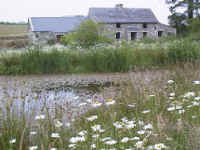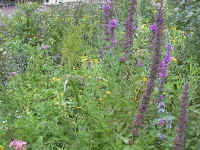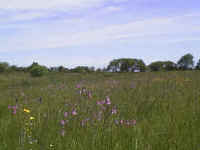|
Native Origin Irish Wildflower Seed Mixtures: Ecotype
Range
Product Code: EC05
Product Name: Wetland Wild Flora (Seasonally Flooded)
EC05 is a vigorous. medium tall mixture which can compete with the often
fertile wetland soils on which many wetlands are situated.

Species List:
Code EC05 Wetland Wild Flora (Seasonally Flooded)
Devils
Bit Scabious
Common Sorrel
Cowslip
Fleabane*
Greater Trefoil*
Hemp Agrimony
Lesser Knapweed
Marsh Cinquefoil
Marsh Marigold
Meadow Buttercup
Meadowsweet
Meadow Rue
Oxeye Daisy
Purple Loosestrife
Ragged Robin
Red Clover
Red Rattle
Ribwort Plantain
Selfheal
Sneezewort*
Tufted Vetch
Water Avens*
Wild Angelica
Wild Valerian
Yarrow
Yellow Flag Iris
Yellow Rattle
Red Rattle*
Corn Marigold
Corn Poppy
Corncockle*
Cornflower*
Scentless Mayweed
Redshank may be added for very wet soils
Marsh Ragwort is not the Common Ragwort which is a noxious weed.

*Denotes
a species that is either of diminished national geno-type or specific to
only a few sites, or who's habitat is increasingly threatened, or the
species is uncommon, rare, becoming rare, is endangered, reintroduced or
saved from extinction.
In all cases, your purchase contributes to DBN's work of creating crops
of Conservation Grade - Native Origin Wildflora. You help us to inform
and pay land-owners to manage native species and to assist DBN in
handing on our heritage for another generation.
By growing (some will be difficult) these and all other species, you
directly help to conserve national and global Biodiversity and protect
wildlife. You should also consider yourself another Irish wildflower
grower.
Product
Warning: While
this Ecotype mixture contains the seed of edible and herbal species, DBN
recommend that this mixture is not for human consumption.

Seed
Mixture Specifications:
Total number of seeds per gram: 2450
Native Irish Origin, Wildflower Seed Mixture. EC05
Suitable for soil type: All types of wet soil Clay, Loam, Sand, Heavy
Soil, and Peat, as long as it remains wet throughout the
year. but not raised Peat
Bog.,
Moisture Level: Moist, Very wet or flooded.
pH range: Best between 5.5 - 7.5
Morphology:
Aspect: Sunny, part shade and not Shaded.
Life Cycle: Annual / Biennial / Mostly Perennial.
Height Range: <30cm to >140cm
Flowering Period: Spring to May to September.
Fertility Range: Will
grow in very fertile soil to poor, if very
infertile apply fertiliser (see below).
Wintergreen: No.
The main species which should dominate and persist: Devils
Bit Scabious, Fleabane, Greater Trefoil, Hemp Agrimony, Lesser Knapweed,
Marsh Marigold, Marsh Ragwort, Meadowsweet, Purple Loosestrife, Ragged
Robin, Water Avens, Wild Angelica, Wild Valerian, Yellow Flag
Iris,
Annual
Species: Red Rattle, The annual Redshank is the best nurse crop on wet soils and is added to this mixture, it will not re-grow after the second year.
Biennial Species:
Wild Angelica.
Unusual species: The general public will
not be familiar with Devils
Bit Scabious, Fleabane, Greater Trefoil, Ragged
Robin, Yellow
Loosestrife, Red Rattle, Water Avens, Wild Angelica, Wild Valerian, of which only fleabane
seem to becoming scarce
Additional species to add to this mixture: From our nursery:
Mint, Bittersweet, a climbing shrub, Brooklime, Bugle, Reed Mace &
Bulrush (if in stock).
Design
Notes: If sown without grasses will this
mixture will not require a nurse crop.
EC05 will grow on a fertile or poor soil as long as the soil is wet or moist in summer. Cut
in late August - Early September as normal until year 3, when you will
have to manage the grasses that develop by cutting.
EC05 may require less cutting beyond year 4, but may need to be cut every 2nd or 3rd year once well
established if grasses are rampant.
REED BEDS.EC05 or EC06 can be sown on biological filters of reeds.
Most species in this mixture
are 'Browse' resistant.
Sowing Specification:
As Normal, roll or rake into surface to
keep out of reach from birds.
Soil Preparation:
Normal, create fine tilt on seed bed,
Optimum Sowing Time: Spring and August
or early September
Sowing Conditions:
Normal, when soil is at its driest. Wetland wildflowers will be
difficult to sow due to the nature of the ecotype, seek advice.
Sowing Method: By hand is recommended, if
using seed spreaders be careful to insure the small varieties of seed do
not drop to the bottom of the seed spreader and get sown all in the one
place. Can be Hydrasown.
Fertiliser: None, Powdered or liquid seaweed will aid germination.
Seed Sowing Rates:
1.5 grams per metre.
Normal
sowing rate 'without added grass seed': 1.5 grams per metre.
High sowing rate 'without added grass seed': Add 3 grams per metre.
Low sowing rate: None
Grass
seed or nurse crop requirement:
Nurse
Crop: No nurse crop is required on soil that is permanently wet.
If the wetland is to be sown on a soil that will become winter wet, due
to flooding annuals can be included in a spring sowing.
Grass Seed Requirement: None. But sedges
can be sown.
Sow with or without grasses: With or without, seek advice.
Sowing rate with grasses: 2 to 4 grams per metre.
50% Flora / 50% grass seed.
If sown without grasses:
This mixture will not require a nurse crop.
Seed Specification:
Once sown this mixture in normal conditions (mainly in early Autumn and
late Spring, when the wetland soil dries out) should germinate 6 weeks
after sowing, from then on provided the sward is kept open and a 'Thatch' is not allowed develop, species will continue to germinate and emerge, through
to the third year.
Up to 40% of all seed should germinate in the first year.
Up to 60% of all species should germinate in 12 months.
Up to 90% of all species
should have flowered by the fourth year after sowing.
Late Autumn and early Summer sowings may be slow to emerge, depending on the weather.
erformance: The third year is the critical year to maintain this meadow to restrict
the growth of grasses native to the site..
If
this mixture is sow with annuals, or contains annuals, they will flower profusely
in the first year, provided they are sown before June. They require one
cut when finished flowering. In the second year the biennials will also
be very colourful. Cut once in late August.
In the third year this meadow mixture will seem
to have less flora than the first and second year. Why?
The perennial species are still young, many will only have
germinated in the second season, so flowers will be sparse. However,
there should be identifiable foliage and some flowers. If not contact
us.
In the second and third the native grasses in your soil will have grown
and will be emerging so strongly that the meadow will require two cuts,
one in Spring and the Second in July or August, the meadow can again be
cut in September if the grasses are still growing strong.
When
should this meadow be established and require one cut.
In the fourth year the perennials in the mixture should be flowering on
many stems and starting to clump and spread, again if the grass is still
vigorous cut in spring and in August of the fourth year. However if the
perennials are growing strong there will be no need to cut until July,
August or September depending on the fertility and wetness of the soil
and the species which have grown.
A
wildflower meadow should last many years, provided the species
established, weeds were controlled and the meadow was cut and the cut
material removed and occasional 'Gaps' are created. If not contact DBN.
Persistence if unmanaged: High
Tolerance of Cutting: Moderate
General Cutting Time: End of Summer, but before the soil becomes
overly wet.
Specific Cutting Time: Wait 3 weeks until after the last flush
of flowers fade away, after seeds set.
Management: Control weeds, especially
Creeping Buttercup. If Creeping Buttercup is present cut this meadow in
May in year two. The third year is the critical year to maintain this
meadow as scutch grass, creeping thistle, nettle and dock will try to
dominate as the growing conditions are ideal for such unwanted species.
A
General Description of Ecotype Range:
Ecotype seed mixtures are
designed to imitate natural ecologies found in specific situations. This
wetland mixture could be found in nearly every county in Ireland. It is
an idea Ecotype seed mixture for nature conservation.
The EC range is not intended as an exact copies of an Irish ecosystem but to represent floras that would otherwise take hundreds of years to develop
if 'nature' was left unaided. This range of seed mixture is ideal for those concerned with encouraging wildlife and local biodiversity as
the plants will attract species suited to the ecology.
If these mixtures are suitable for your situation, they offer good value, contain some of the most exacting and unusual species and if
given time, develop into a diverse flora that will persist if properly maintained.
|


